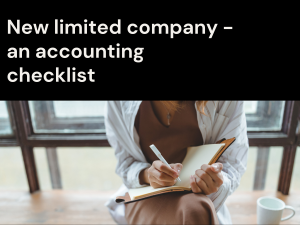What are management accounts?
Most small businesses are familiar with financial accounts. These are usually prepared annually for things like filing with Companies House and to complete your business tax return. So, whilst they give you a picture of your business at a particular point in time, they are also historic and backward looking meaning they’re regularly maligned by business owners as not being particularly useful.
Management accounts bridge this gap. Management accounts are strategic, timely, and designed for business owners to make decisions that will shape the next month, quarter or year. They are produced on a regular basis, usually monthly or quarterly, and give you a snapshot of your business’s health in real time. They help you to spot trends and opportunities, address issues early and keep on track. To put it simply – they’re useful, more than useful in fact, they’re essential if you’re serious about developing your business.
Management accounts – they’re at your fingertips
These days, most small businesses have a fairly well-oiled bookkeeping function. Hopefully, this is the case for you, meaning you’re already using cloud software combined with a receipt scanning solution and reconciling transactions on a regular basis (if you’re not – talk to us!). Assuming this is the case, then management accounts are closer than you realise.
That’s because the hard work has already been completed – it’s now just a case of creating a number of reports which give you the information you need. These reports typically combine both a financial summary with charts and graphs to give you a visual representation that can be particularly powerful in spotting trends. So, what reports, and information should you expect to find in your management accounts?
What should a small business expect to find in its management accounts?
Your management accounts will be made up of a number of items, each of which we explore below. Together, these form a management reporting pack, and it is only by having all or at least most of the items below that you will really have the information you need to make decisions about your business.
Exec Summary
The Exec summary is what brings all the documents together – it is a descriptive narrative that highlights key information, discusses trends, or flags weaknesses. If you’re still getting up to speed with how to interpret your management accounts then the Exec summary is a good place to start, as it will communicate the key information in simple, jargon-free terms.
KPI’s
KPI’s stand for Key Performance Indicators and can be very useful to measure a business’s performance. Generally, the business will identify KPI’s that will provide it with relevant information based on current objectives and targets. For example, if a business primary focus is growing sales it may monitor turnover on a quarterly or monthly basis and create a KPI for that. Of course, KPI’s can also be non-financial, for example, the business may measure number of customer reviews or number of unique visits to its website. So, this can be a useful place to combine both financial and non-financial information for management and the business owners to review.
Profit and Loss
Similar to the profit and loss that you are used to seeing in your financial accounts, this report will measure profit and loss over a specific time period, such as a month or quarter. A good profit and loss report will also show cumulative profit to date and compare this against prior year and any budgets which you have set.
Balance Sheet
The balance sheet is a report that shows your total assets and liabilities along with your capital accounts (things like share capital and retained profits).
Aged Receivables
Aged receivables give you a snapshot of who owes you what, how much they owe you and when it is due. It’s particularly useful for identifying overdue payments which you can then speak to your customers about to find out when payment will be received.
Aged Payables
Aged payables are simply the opposite of aged receivables, they show who your business owes money to, how much you owe and when it’s due to be paid. You shouldn’t underestimate the power of your aged payables. Some businesses can improve their cash balance simply by paying suppliers when they’re due rather than before. But it also means you know what needs to be paid and when, keeping you on good terms with your suppliers.
Cash Forecast
Too many businesses still fail to focus on the importance of cash. Without it, most businesses quickly fail. The cash forecast shows what your expected inflows and outflows are over the next month or quarter. It helps to predict your cash balance and spot issues early.
How will management accounts help your small business?
We now know what management accounts are, and what you should expect to find in your management accounts but how will they actually help your small business?
We’ve spoken to lots of small business owners who find that as they’re business grows, they lose a grip on their finances. It becomes harder to track inflows and outflows, to know what to set aside for your corporation tax or VAT bill and if you’re able to take on that new employee. Continuing down this path is the equivalent of putting a blind fold on why you run your business.
This is where management accounts can help. They will tell you the real-time, up to date story of what is happening in your business. They give you the information you need to make these decisions, to set aside cash for your tax bills and to grow. They can also help you to:
- Improve profits – regular reporting means you can identify more profitable products or services and promote these they can also enable you to recoup money you may have left on the table with a client.
- Reduce costs – by monitoring your expenses you can quickly identify costs which are higher than expected or which you may no longer need.
- Spot trends – regular reporting enables you to identify your strengths and weaknesses and home in on these. Maybe your poor at chasing receivables, leaving too much money in the hands of your customers or maybe sales have flatlined and it’s time to focus on marketing activity.
Summary
As we’ve already seen, where a business is using cloud accounting these reports are usually available with just a small amount of effort so we encourage every small business to start reviewing their management accounts. Just set aside 1 hour each month or quarter to sit down and review where things are at – you won’t regret it.
If you’re looking for help with management accounting, real-time bookkeeping or cloud software then get in touch and let’s have a chat.






